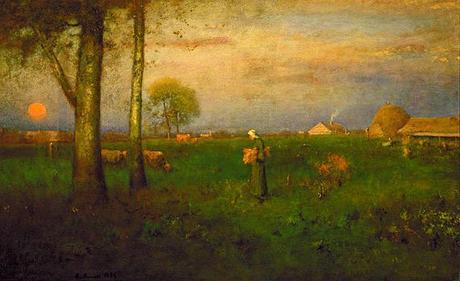
Sundown by George Inness
George Inness (1825-1894) has been like a thorn in my side for the past year, so when I learned that we share the same birthday (May 1st), 150 years apart, I softened to the great nineteenth-century landscape painter. The reason he's a thorn in my side is because I have been updating over 2,000 records of his works in the National Art Inventories for weeks.
Several years ago, a contractor working in our office asked me, “Why would anyone use the Inventories?” I told him that in addition to being a location guide to where an artists' works are located, the Inventories also provide links to more detailed information on the artist or artwork. I suggested he try to see the Inventories as a bibliography of sorts, since every record contains at least one and often more citations to where information could be found. Looking at an Inventory record, you might see the artwork is listed in three exhibition catalogues and two collection catalogues, and even have the exact page number to look for when you find the book in the library. This is especially useful for older exhibition catalogues that often do not include indices.
As a cataloguer, the fascinating part of my job is learning in-depth about an artist’s work. Page by page, year by year, I have made my way through Inness’s oeuvre. I have seen, painting by painting, the progression of his work from when he was a young man to his last painting of Montclair, New Jersey in 1894. From his Hudson River landscapes near his hometown of Newburgh, N.Y., to his paintings of Medfield, Massachusetts, from landscapes with cows and sheep, wood interiors, sunsets, and moonscapes to riverscapes and farming scenes, Niagara Falls and autumn landscapes, he seems to have painted the entire rural experience. So when I call him a thorn in my side, it's because I sometimes get bogged down by the monotony of so many similar paintings. When that happens I take a break and return later with fresh eyes.
This is a marvelous journey to be on. There are other artists I have worked this closely with, including Georgia O’Keeffe, John Singer Sargent, and William Merritt Chase. Although knowledge is great, the most rewarding part of my job is walking over to the museum and seeing works by these artists in person. Even the best color plates, though spectacular, are no substitute for the real thing.
Did you know that the Art Inventories began in 1971? Read more about its long history.

